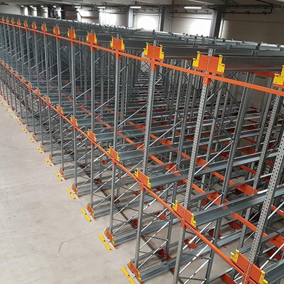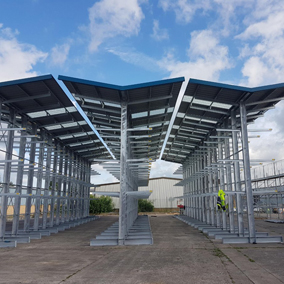About Us
Outdoor hot-dip galvanized cantilever racking requires precise load-bearing calculations for safe use.
Views : 2339
Update time : 2025-07-15 13:34:00
Calculating the load-bearing capacity of hot-dip galvanized outdoor cantilever racking requires a comprehensive consideration of the mechanical properties of structural components, connection strength, overall stability, and external environmental loads. It follows the logic of "from components to the whole, from static to dynamic," combined with material characteristics and industry standards (such as China's GB/T 28576 Cantilever Racking and international ANSI MH16.1 Industrial Racking Design Specification). Here are the specific steps and key points:
I. Clarify Core Parameters and Preconditions
Before calculation, basic parameters of the rack must be determined, as these are the input conditions for all calculations:
- Material parameters
- Steel grade (e.g., Q235B, Q345B): Its yield strength (σₛ) and tensile strength (σᵦ) must be specified. For example, Q235B has a yield strength of approximately 235MPa, and Q345B about 345MPa.
- Component dimensions:
- Columns: Cross-sectional dimensions (e.g., H-beam 150×75×5×7, square tube 100×100×5, etc.) and height (affecting stability).
- Cantilever arms: Cross-sectional dimensions (e.g., circular tube Φ89×5, rectangular tube 100×50×4, etc.) and length (distance from the column center to the end of the cantilever, i.e., the force arm).
- Connectors: Bolt specifications (e.g., M12 high-strength bolts) and weld dimensions (e.g., weld leg height h₆).
- Structural parameters
- Cantilever spacing: Vertical distance between adjacent cantilevers (affecting the uniformity of cargo placement).
- Number of cantilevers: Single-sided or double-sided, and the number of cantilevers per row of columns.
- Column fixing method: Embedded (fixed to concrete foundations) or expansion bolt type (fixed to the ground).
- Usage conditions
- Load types: Static loads (self-weight of goods) and dynamic loads (impact during forklift loading/unloading, usually 1.1-1.3 times the static load).
- Cargo placement: Uniformly distributed (e.g., entire steel bars laid flat) or concentrated loads (e.g., cargo center of gravity deviating from the cantilever center).
- Outdoor environmental loads: Wind loads (calculated based on local wind speed, such as basic wind pressure of 0.5kN/m²) and snow loads (calculated based on snowfall), which add horizontal or vertical additional loads.
II. Load-Bearing Calculation for Key Components
The load-bearing capacity of cantilever racking is determined by the weakest component (the "bucket effect"). The load limits of cantilever arms, columns, and connectors must be calculated separately, with the minimum value taken as the safe load of a single cantilever.
1. Load-bearing calculation for cantilever arms (core load-bearing components)
Cantilever arms are key load-bearing members that withstand vertical pressure from goods, generating bending stress and shear stress. They must meet bending and shear strength requirements.
- Bending strength calculation
A cantilever arm can be regarded as a "cantilever beam with one end fixed (connected to the column) and the other end free." When a load F is applied at the end, the maximum bending moment M occurs at the fixed end (connection to the column):
(Where: F = load at the end of the cantilever, in N; L = length of the cantilever, in m)The bending stress σ must be less than the allowable bending stress [σ] of the material (allowable stress = yield strength σₛ ÷ safety factor n; n = 1.5-2.0 for static loads, 2.0-3.0 for dynamic loads):
(Where: W_z = section modulus of the cantilever cross-section, in m³, calculated based on the cross-sectional shape. For example, W_z for a circular tube = π(d⁴-d₁⁴)/(32d); for a rectangular tube = bh²/6; for H-beams, refer to steel section tables.)The maximum allowable load for the cantilever arm is derived as: - Shear strength calculation
The shear stress τ of the cantilever arm must be less than the allowable shear stress [τ] of the material (usually [τ] ≈ 0.6×[σ]):
(Where: A = shear area of the cantilever cross-section, in m². For example, A for a circular tube = π(d²-d₁²)/4)The allowable shear load is derived as:The safe load of the cantilever arm is the minimum of the bending and shear strength results:
2. Load-bearing calculation for columns
Columns bear the total vertical load (sum) transmitted by cantilevers and horizontal loads (horizontal forces from wind, snow, or cargo impact). They must meet axial compression strength and stability requirements (to prevent column buckling).
- Axial compression strength calculation
The total vertical load N on a column is the sum of loads transmitted by all cantilevers (if a column has n cantilevers, each with load F, then N = n×F):
The axial compressive stress σ must be less than the allowable compressive stress [σ]:
(Where: A_{\text{column}} = cross-sectional area of the column, in m²) - Stability calculation (critical)
Slender columns may undergo "buckling instability" (sudden bending) under axial pressure. The stability coefficient φ (related to the slenderness ratio λ) is a core parameter, as specified in Code for Design of Steel Structures GB 50017:
(Where: μ = length coefficient, μ = 2 for cantilever rack columns with fixed bottom and free top; H = height of the column, in m; i = radius of gyration of the cross-section, in m, i = √(I/A), where I = moment of inertia of the cross-section)The stable bearing capacity Nₛ is:The safe load of the column must meet both axial compression and stability requirements, with the minimum value taken.
3. Load-bearing calculation for connectors
Connectors (bolts or welds) are "bridges" for load transmission. Insufficient strength can cause cantilevers to separate from columns, so their shear, tensile, or welding strength must be calculated.
- Bolted connections
The shear capacity Fᵦ of a single bolt:
(Where: nᵦ = number of shear planes of the bolt; d = bolt diameter; t = thickness of the connecting plate; [τᵦ] = allowable shear stress of the bolt) - Welded connections
The shear capacity F_w of fillet welds:
(Where: l_w = effective length of the weld; h_f = weld leg height; [τ_f] = allowable shear stress of the weld)
III. Load-Bearing Verification for the Overall Structure
After determining the safe load of a single cantilever, the total load capacity is calculated based on the overall layout of the rack (e.g., column spacing, number of cantilever rows), and the following overall stability must be verified:
- Anti-overturning stability
Outdoor racks must resist horizontal forces (e.g., wind loads) to prevent overall overturning. The anti-overturning safety factor K must be ≥ 1.5:
(Where: M_{\text{anti-overturn}} = anti-overturning moment from the self-weight of goods and the rack; M_{\text{overturn}} = overturning moment from wind loads, etc.) - Foundation bearing capacity verification
The rack foundation (concrete or ground) must bear the total vertical load, and the pressure on the foundation base must be less than the characteristic value of foundation bearing capacity fₐ:
IV. Safety Factors and Industry Standards
Safety factors must be introduced during calculation to account for uncertainties such as material defects, processing errors, and load fluctuations:
- Static loads: Safety factor n = 1.5-2.0
- Dynamic loads (e.g., forklift loading/unloading): n = 2.0-3.0
- Outdoor environments (corrosion, temperature changes): An additional 10-20% safety margin is recommended
Summary: Simplified Calculation Steps
- Determine material, structural, and environmental parameters;
- Calculate the load limits of cantilever arms, columns, and connectors separately;
- Take the minimum component value as the load capacity of a single cantilever;
- Verify overall anti-overturning stability and foundation bearing capacity;
- Multiply by the safety factor to obtain the final safe load capacity.
Notes
- The hot-dip galvanizing process only affects corrosion resistance, not the mechanical properties of steel. Calculations should still use base material parameters;
- Goods must be placed uniformly to avoid concentrated loads exceeding the single cantilever limit;
- For large-span or heavy-load racks, simulation with finite element software (e.g., ANSYS, SolidWorks) or third-party testing is recommended for verification.
Following these steps ensures that the load-bearing capacity of hot-dip galvanized outdoor cantilever racking meets both operational needs and safety standards.
相关新闻
 Looking for Mesh Decking Manufacturers?
Looking for Mesh Decking Manufacturers?
Aug 25,2025
Mesh decking, a critical component in warehouse storage systems (e.g., pallet racks), is characterized by its grid-like metal structure. It offers exceptional load-bearing capacity, ventilation, and visibility, making it ideal for storing pallets, cartons, and bulk items across industries such as logistics, manufacturing, and retail.
Key features of high-quality mesh decking typically include:
Durable Material: Usually made of carbon steel or galvanized steel for corrosion resistance and long service life.
Safety Design: Equipped with anti-slip surfaces, reinforced edges, and secure locking mechanisms to prevent load slippage.
Customizability: Available in various sizes (length, width, height), mesh hole densities, and load ratings to fit different rack configurations.
 How does a shuttle system work? Boost Warehouse Productivity with Pallet Shuttle Racking Solutions
How does a shuttle system work? Boost Warehouse Productivity with Pallet Shuttle Racking Solutions
Aug 05,2025
How does a shuttle system work?
A pallet shuttle system is a semi-automated storage solution where a motorized shuttle moves pallets along rails within a racking structure. Controlled by remote or software, it enhances storage density and retrieval efficiency in deep-lane configurations, reducing the need for forklifts to enter the racks.
Jul 22,2025
Wire containers, also known as wire mesh containers or industrial wire baskets, offer a versatile, durable, and cost-effective solution for warehouse organization, inventory management, and secure shipping. Designed with high-quality steel wire and a robust mesh structure, these stackable wire baskets provide exceptional visibility, ventilation, and strength, making them ideal for a wide range of industries, from manufacturing to retail.
 Outdoor hot-dip galvanized cantilever racking requires precise load-bearing calculations for safe use.
Outdoor hot-dip galvanized cantilever racking requires precise load-bearing calculations for safe use.
Jul 15,2025
Calculating the load-bearing capacity of hot-dip galvanized outdoor cantilever racking requires a comprehensive consideration of the mechanical properties of structural components, connection strength, overall stability, and external environmental loads. It follows the logic of "from components to the whole, from static to dynamic," combined with material characteristics and industry standards (such as China's GB/T 28576 Cantilever Racking and international ANSI MH16.1 Industrial Racking Design Specification). Here are the specific steps and key points:

